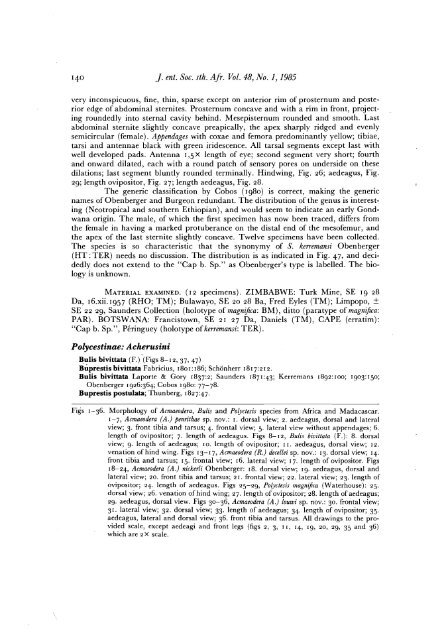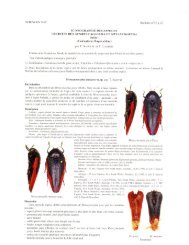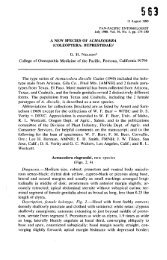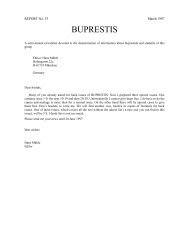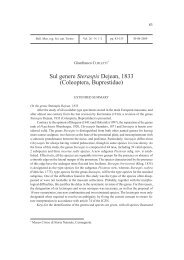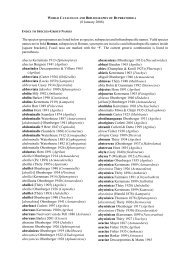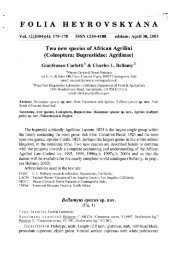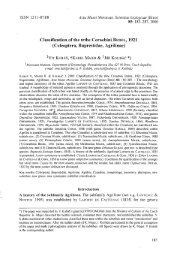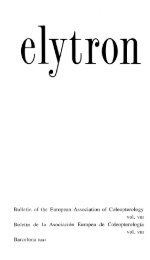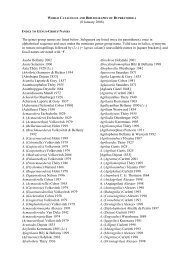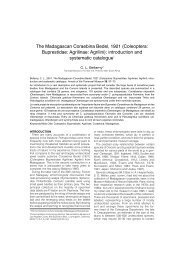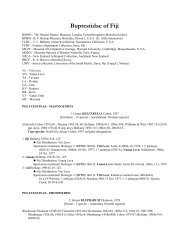Coleoptera: Buprestidae
Coleoptera: Buprestidae
Coleoptera: Buprestidae
You also want an ePaper? Increase the reach of your titles
YUMPU automatically turns print PDFs into web optimized ePapers that Google loves.
J. ent. Soc. sth. Afr. Vol. 48, No. 1,1985<br />
very inconspicuous, fine, thin, sparse except on anterior rim of prosternum and poste-<br />
rior edge of abdominal sternites. Prosternum concave and with a rim in front, project-<br />
ing roundedly into sternal cavity behind. Mesepisternum rounded and smooth. Last<br />
abdominal sternite slightly concave preapically, the apex sharply ridged and evenly<br />
semicircular (female). Appendages with coxae and femora predominantly yellow; tibiae,<br />
tarsi and antennae black with green iridescence. All tarsal segments except last with<br />
well developed pads. Antenna 1 ,5X length of eye; second segment very short; fourth<br />
and onward dilated, each with a round patch of sensory pores on underside on these<br />
dilations; last segment bluntly rounded terminally. Hindwing, Fig. 26; aedeagus, Fig.<br />
29; length ovipositor, Fig. 27; length aedeagus, Fig. 28.<br />
The generic classification by Cobos (1980) is correct, making the generic<br />
names of Obenberger and Burgeon redundant. The distribution of the genus is interest-<br />
ing (Neotropical and southern Ethiopian), and would seem to indicate an early Gond-<br />
wana origin. The male, of which the first specimen has now been traced, differs from<br />
the female in having a marked protuberance on the distal end of the mesofemur, and<br />
the apex of the last sternite slightly concave. Twelve specimens have been collected.<br />
The species is so characteristic that the synonymy of S. kerremansi Obenberger<br />
(HT: TER) needs no discussion. The distribution is as indicated in Fig. 47, and deci-<br />
dedly does not extend to the "Cap b. Sp." as Obenberger's type is labelled. The bio-<br />
logy is unknown.<br />
MATERIAL EXAMINED. (12 specimens). ZIMBABWE: Turk Mine, SE 19 28<br />
Da, 16.xii.1957 (RHO; TM); Bulawayo, SE 20 28 Ba, Fred Eyles (TM); Limpopo, k<br />
SE 22 29, Saunders Collection (holotype of magnijica: BM), ditto (paratype of magnzjka:<br />
PAR). BOTSWANA: Francistown, SE 21 27 Da, Daniels (TM), CAPE (erratim):<br />
"Cap b. Sp.", Piringuey (holotype of kerremansi: TER).<br />
Polycestinae: Acherusini<br />
Bulis bivittata (F.) (Figs 8-1 2, 37, 47)<br />
~u~restis bivittata Fabricius, I 80 I : I 86; Schonherr I 8 I 7:2 I 2.<br />
Bulis bivittata Laporte & Gory I 837:2; Saunders I 87 1 :43; Kerremans I 892: I 00; I 903: I 50;<br />
Obenberger 1 g26:364; Cobos I 980: 77-78.<br />
Buprestis postulata; Thunberg, I 827:47.<br />
Figs 1-36. Morphology of Acmaeodera, Bulis and Polyctesis species from Africa and Madacascar.<br />
1-7, Acmaeodera (A.) penrithae sp. nov.: I. dorsal view; 2. aedeagus, dorsal and lateral<br />
view; 3. front tibia and tarsus; 4. frontal view; 5, lateral view without appendages; 6.<br />
length of ovipositor; 7. length of aedeagus. Figs 8-12, Bulis bivittata (F.): 8. dorsal<br />
view; 9. length of aedeagus; I o. length of ovipositor; I I. aedeagus, dorsal view; I 2.<br />
venation of hind wing. Figs 13-17, Acmaeodera (R.) decellei sp. nov.: 13. dorsal view; 14.<br />
front tibia and tarsus; 15. frontal view; 16. lateral view; 17. length of ovipositor. Figs<br />
I 8-24, Amaeodera (A.) nickerli Obenberger: I 8. dorsal view; I g. aedeagus, dorsal and<br />
lateral view; 20. front tibia and tarsus; 21. frontal view; 22. lateral view; 23. length of<br />
ovipositor; 24. length of aedeagus. Figs 25-29, Polyctesis magnijca (Waterhouse): 25.<br />
dorsal view; 26. venation of hind wing; 27. length of ovipositor; 28. length of aedeagus;<br />
29. aedeagus, dorsal view. Figs 30-36, Amaeodera (A.) louwi sp. nov.: 30. frontal view;<br />
31. lateral view; 32. dorsal view; 33. length of aedeagus; 34. length of ovipositor; 35.<br />
aedeagus, lateral and dorsal view; 36. front tibia and tarsus. All drawings to the pro-<br />
vided scale, except aedeagi and front legs (figs 2, 3, I I, 14, 19, 20, 29, 35 and 36)<br />
which are 2 x scale.


